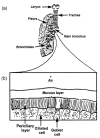Mathematical Modeling of Mucociliary Clearance: A Mini-Review
- PMID: 31323757
- PMCID: PMC6678682
- DOI: 10.3390/cells8070736
Mathematical Modeling of Mucociliary Clearance: A Mini-Review
Abstract
Mucociliary clearance is an important innate host defense of the mammalian respiratory system, as it traps foreign substances, including pollutants, pathogens, and allergens, and transports them out of the airway. The underlying mechanism of the actuation and coordination of cilia, the interplay between the cilia and mucus, and the formation of the metachronal wave have been explored extensively both experimentally and mathematically. In this mini-review, we provide a survey of the mathematical models of mucociliary clearance, from the motion of one single cilium to the emergence of the metachronal wave in a group of them, from the fundamental theoretical study to the state-of-the-art three-dimensional simulations. The mechanism of cilium actuation is discussed, together with the mathematical simplification and the implications or caveats of the results.
Keywords: cilia; clearance; mathematical modeling; mucus.
Conflict of interest statement
The authors declare no conflict of interest.
Figures






Similar articles
-
Cilium height difference between strokes is more effective in driving fluid transport in mucociliary clearance: A numerical study.Math Biosci Eng. 2015 Oct;12(5):1107-26. doi: 10.3934/mbe.2015.12.1107. Math Biosci Eng. 2015. PMID: 26280187
-
Role of cilia, mucus, and airway surface liquid in mucociliary dysfunction: lessons from mouse models.J Aerosol Med Pulm Drug Deliv. 2008 Mar;21(1):13-24. doi: 10.1089/jamp.2007.0659. J Aerosol Med Pulm Drug Deliv. 2008. PMID: 18518828 Review.
-
Continuous mucociliary transport by primary human airway epithelial cells in vitro.Am J Physiol Lung Cell Mol Physiol. 2015 Jul 15;309(2):L99-108. doi: 10.1152/ajplung.00024.2015. Epub 2015 May 15. Am J Physiol Lung Cell Mol Physiol. 2015. PMID: 25979076 Free PMC article.
-
The propulsion of mucus by cilia.Am Rev Respir Dis. 1988 Mar;137(3):726-41. doi: 10.1164/ajrccm/137.3.726. Am Rev Respir Dis. 1988. PMID: 3278666 Review.
-
A quantitative interspecies comparison of the respiratory mucociliary clearance mechanism.Eur Biophys J. 2022 Jan;51(1):51-65. doi: 10.1007/s00249-021-01584-8. Epub 2022 Jan 24. Eur Biophys J. 2022. PMID: 35072746 Free PMC article.
Cited by
-
Effects of continuous and discrete boundary conditions on the movement of upper-convected maxwell and Newtonian mucus layers in coughing and sneezing.Eur Phys J Plus. 2022;137(7):846. doi: 10.1140/epjp/s13360-022-03067-x. Epub 2022 Jul 21. Eur Phys J Plus. 2022. PMID: 35892063 Free PMC article.
-
Human exposure to PM10 microplastics in indoor air.PLoS One. 2025 Jul 30;20(7):e0328011. doi: 10.1371/journal.pone.0328011. eCollection 2025. PLoS One. 2025. PMID: 40737229 Free PMC article.
-
In vivo detection of pulmonary mucociliary clearance: present challenges and future directions.Eur Respir Rev. 2024 Sep 18;33(173):240073. doi: 10.1183/16000617.0073-2024. Print 2024 Jul. Eur Respir Rev. 2024. PMID: 39293852 Free PMC article. Review.
-
The Potential Role and Regulatory Mechanisms of MUC5AC in Chronic Obstructive Pulmonary Disease.Molecules. 2020 Sep 27;25(19):4437. doi: 10.3390/molecules25194437. Molecules. 2020. PMID: 32992527 Free PMC article. Review.
-
Mucociliary clearance affected by mucus-periciliary interface stimulations using analytical solution during cough and sneeze.Eur Phys J Plus. 2023;138(3):201. doi: 10.1140/epjp/s13360-023-03796-7. Epub 2023 Mar 3. Eur Phys J Plus. 2023. PMID: 36883183 Free PMC article.
References
-
- Fauci L.J., Dillon R. Biofluidmechanics of reproduction. Annu. Rev. Fluid Mech. 2006;38:371–394. doi: 10.1146/annurev.fluid.37.061903.175725. - DOI
Publication types
MeSH terms
Grants and funding
LinkOut - more resources
Full Text Sources

